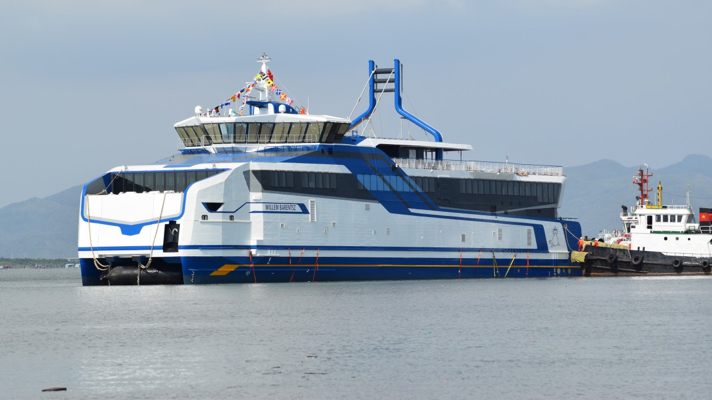In June, the new ferry MV Willem Barentsz from Rederij Doeksen will finally be put into service after delay upon delay during its construction. From that date on, the LNG-powered catamaran will provide data for the Clinsh monitoring programme on emissions.
Originally, the aluminium catamaran car ferry was supposed to be delivered at the end of 2017 along with sister ship MV Willem de Vlamingh. Vietnamese shipyard Strategic Marine suffered financial difficulties while constructing the vessels. This meant that although the keels were laid on on 15 July and 9 August 2016, the ships could not be launched until 8 and 12 January 2019. Finally, Doeksen decided to bring the ships to the Netherlands for finishing, but they suffered water damage during transport causing yet more delays.
The lengthy construction process is now finally at an end, with the Willem Barentsz almost ready for sea trials. Together with the Willem de Vlamingh, the ferries will provide the ferry services between Harlingen and the Dutch Wadden Islands Terschelling and Vlieland.
The two identical ropax catamarans use LNG. In addition to the fact that the ships provide more car deck capacity, the ships are much less harmful to the environment than the current diesel-powered ships. ‘We operate in the Wadden Sea, a vulnerable and protected nature reserve with Unesco World Heritage status. Our ships have to fit in there,’ says Paul Melles, Managing Director of Rederij Doeksen.
Clinsh monitoring programme
Clinch stands for CLean INland SHipping. The main objective of this European consortium consisting of Dutch, Belgian, German and English public and private organisations is to improve air quality in urban areas by accelerating emission reductions in inland waterway transport.
Doeksen sees the opportunity to participate in the monitoring programme of the Clinsh project as an excellent opportunity to make “greening efforts” measurable. Melles: ‘By participating in the monitoring programme, we can provide insight into the emissions of our new ships and show that LNG is actually a more environmentally friendly alternative to diesel. Especially if we can use bio-LNG in the future: we can even save up to eighty per cent CO2 without having to adjust the on-board installation.’
The results of the emission monitoring of the MV Willem Barentsz are expected in the second half of 2020.
Picture: The Willem Barentsz shortly after its launch (from “Maand Maritiem”, SWZ|Maritime February 2019).








